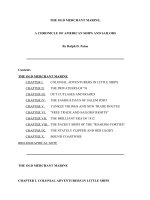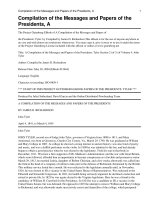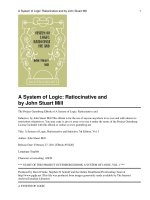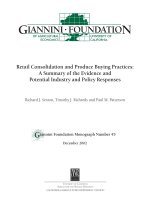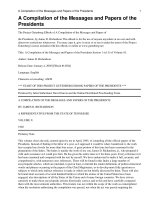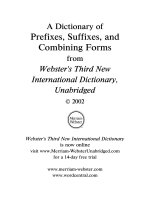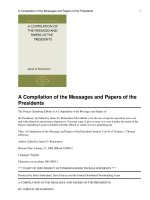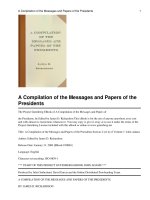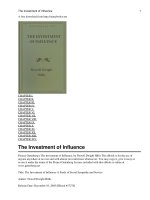edinburgh university pres a glossary of us politics and government jun 2007
Bạn đang xem bản rút gọn của tài liệu. Xem và tải ngay bản đầy đủ của tài liệu tại đây (820.38 KB, 207 trang )
P O L I T I C S G L O S S A R I E S
Cover design: Cathy Sprent
Edinburgh University Press
22 George Square
Edinburgh EH8 9LF
www.eup.ed.ac.uk
ISBN 0 7486 2253 5
P O L I T I C S G L O S S A R I E S
Series Editor: Keith Faulks
Glossaries in this series provide brief, clear and convenient A–Z
guides to the central concepts of the various branches of politics.
They are thorough, authoritative and concise reference works
which offer clear and consistent coverage of both traditional and
contemporary terminology.
Volumes in the series provide:
• Dedicated coverage of particular topics within politics
• Coverage of key terms and major figures
• Practical examples of the terms defined
• Cross-references to related terms
Alex Thomson
A GLOSSARY OF
A Glossary of US Politics & Government
Alex Thomson
This glossary explains the key concepts, institutions, personalities and events
most commonly referred to in the teaching of US politics and government.
The emphasis is on accessibility in order to provide students with a ready
source of knowledge which can supplement core reading. The book will help
students to address any gaps they may have in their understanding of US
politics which, in turn, will make studying this fascinating subject all the
more rewarding and enjoyable.
Alex Thomson is Principal Lecturer in Politics at Coventry University.
His previous publications include Incomplete Engagement: US Foreign Policy
Towards the Republic of South Africa (1996), An Introduction to African Politics
(2000; second edition 2004) and (as co-author) Get Set for Politics
(Edinburgh University Press, 2003).
US POLITICS
& GOVERN
MENT
Edinburgh
US POLITICS & GOVERNMENT
THOMSON
A GLOSSARY OF
A GLOSSARY OF US POLITICS
AND GOVERNMENT
M538 - THOMSON PRE M/UP 13/12/06 12:26 pm Page i Phil's G4 Phil's G4:Users:phi
Politics Glossaries
Series Editor: Keith Faulks
This series introduces key terms within the core subject areas of
politics. The aim is to provide a brief, clear and convenient A–Z
guide to the central concepts of the various branches of politics.
The series provides thorough, authoritative and concise ref-
erence works which offer clear and consistent coverage of
both traditional and contemporary terminology. Students and
teachers of politics at all levels of study will find the books
invaluable, though the books are aimed primarily at readers
new to a subject area. In addition to appealing to mainstream
politics students, the series will also appeal to those studying
courses in sociology, journalism, media studies and social
policy that include elements of politics.
Volumes in the series provide:
■
Dedicated coverage of particular topics within politics
■
Coverage of key terms and major figures
■
Practical examples of the terms defined
■
Cross-references to related terms
Titles in the series include:
John Hoffman, A Glossary of Political Theory
Alistair Jones, A Glossary of the European Union
Alex Thomson, A Glossary of US Politics and Government
Duncan Watts, A Glossary of UK Government and Politics
M538 - THOMSON PRE M/UP 13/12/06 12:26 pm Page ii Phil's G4 Phil's G4:Users:ph
A Glossary of US Politics
and Government
Alex Thomson
Edinburgh University Press
M538 - THOMSON PRE M/UP 13/12/06 12:26 pm Page iii Phil's G4 Phil's G4:Users:p
© Alex Thomson, 2007
Edinburgh University Press Ltd
22 George Square, Edinburgh
Typeset in 10.5/13 Sabon by
Servis Filmsetting Ltd, Manchester, and
printed and bound in Great Britain by
Cox & Wyman Ltd, Reading
A CIP record for this book is
available from the British Library
ISBN 978 0 7486 2804 9 (hardback)
ISBN 978 0 7486 2253 5 (paperback)
The right of Alex Thomson
to be identified as author of this work
has been asserted in accordance with
the Copyright, Designs and Patents Act 1988.
M538 - THOMSON PRE M/UP 13/12/06 12:26 pm Page iv Phil's G4 Phil's G4:Users:ph
Contents
Preface vi
A Glossary of US Politics and Government 1
Appendix A Presidents and Vice Presidents of the
United States 188
Appendix B Chief Justices of the United States 192
Appendix C Historic Strength of Political Parties
within the US Federal Government 193
M538 - THOMSON PRE M/UP 13/12/06 12:26 pm Page v Phil's G4 Phil's G4:Users:phi
Preface
The United States houses one of the most intricate systems of
government in the world, and produces politics of a complex
nature. As a result, to understand this political arena, one
needs to take on board many variables: the functions of a
whole host of individual institutions; key political events that
have occurred over some 250 years; individuals who have
shaped this history; and the numerous expressions scholars
have ‘coined’ in order to explain this political system. This
may seem daunting at first. One has to sort out the legislative
branch from the executive branch, and then work out where
the Supreme Court resides in this political dispensation. This
is before one realises that the federal government is only part
of the equation, and that there are fifty other sovereign gov-
ernments in the USA: those belonging to the individual states.
And then there are the people and organisations that inhabit
this system of government (politicians, political parties, inter-
est groups, government departments, courts, independent
agencies, and so on). Not to mention methods of represent-
ation, in terms of general elections, primary elections, recall
votes, state initiatives, lobbying and so forth. One needs some
kind of mental map in order to put all these fragments of gov-
ernment and politics back together, to gain an overall picture.
Most use the US constitution as the starting point for drawing
this map. And the constitution itself introduces a plethora of
phrases that need to be understood (the commerce clause,
denied powers, strict construction – again the list goes on). If
M538 - THOMSON PRE M/UP 13/12/06 12:26 pm Page vi Phil's G4 Phil's G4:Users:ph
you are serious about wanting to comprehend US politics and
government there is a lot to learn.
The good news is that assistance is at hand: literally. This
book is specifically designed to help you understand the above
events, institutions and terminology, and many more key
words and phrases besides. It is not a comprehensive and
exhaustive twelve-volume encyclopaedia of everything related
to US politics and government, nor is it meant to be a substi-
tute for the vast literature of books and articles published on
this subject. Additionally, it is not a general political dictio-
nary. There are no non-US-specific entries, such as ‘democ-
racy’ in general or a broad consideration of ‘socialism’. The
book is, instead, dedicated to terms that provide a good start-
ing point for a journey into the politics of this part of the
world.
A Glossary of US Politics and Government works best
when read alongside other texts. It will help newcomers to this
subject understand a phrase or concept they come across in
their other reading, while more knowledgeable scholars can
use the entries in this book to clarify or remind themselves
about a term previously encountered. Once you have looked
up a word, and satisfied yourself of its meaning, you can then
return to studying the key texts. However, having said this,
there is nothing to stop you browsing. Inevitably with glos-
saries, one often finds oneself following a path, with one entry
leading to another: separation of the powers leads to Supreme
Court, which leads to Brown v. Board of Education, 1954,
which leads to civil rights movement, and so on. Glossary
browsing is a great way to build up knowledge of a subject,
but remember, the best way to learn is to eventually get back
to the key texts! This book is only designed to give snap-shots,
helping you digest more comprehensive volumes.
So, what is actually in this book? Well, it is a collection of
500 or so explanations of often-used terms and phrases found
in the study of US politics and government. These are listed
PREFACE vii
M538 - THOMSON PRE M/UP 13/12/06 12:26 pm Page vii Phil's G4 Phil's G4:Users:p
in strict alphabetical order. The entries have been selected
around four themes: institutions, historical events, expres-
sions and personalities. Enough information is given to help
one understand an issue, but the entries are deliberately
concise in order not to bog the reader down with too many
facts and detain them too long. Remember, the book is a com-
panion to other recommended reading, not a substitute for it.
In addition to the 500 or so entries that make up the vast
bulk of this book are three appendices: ‘US Presidents and
Vice Presidents’, ‘US Supreme Court Chief Justices’, and
details of the US Congress since this body’s first session. These
tables can be referred to when you need to confirm who was
President or Chief Justice when, and which political party
controlled the US Congress or the White House at a certain
point in history. These are the types of sources that even the
most experienced scholar of US politics has to turn to every
now and then: when they forget which President succeeded
William Henry Harrison in 1841, for example, after he died
in office. In times of need or forgetfulness, we all need aide
memoires, such as the present book.
I also thought it would be useful to include the URLs of
websites at the end of selected glossary entries. These are the
official home-pages of the institutions concerned: the US
Senate, for example, or the National Rifle Association. These
URLs, however, have been confined to official sites. Readers
may wish to search beyond these particular web pages,
seeking a more critical view of these institutions. Similarly,
one or two entries include further reading recommendations.
Such recommendations have only been given when a specific
book is mentioned in the text. Rather than overwhelm readers
with several suggested books for each individual glossary
entry, it would probably be better to start with a holistic view,
and consult a couple of good text books instead. Two
volumes, in particular, come highly recommended: George
McKay’s American Politics and Society (Oxford: Blackwell,
viii PREFACE
M538 - THOMSON PRE M/UP 13/12/06 12:26 pm Page viii Phil's G4 Phil's G4:Users:
2005), and The Irony of Democracy, written by Thomas R.
Dye and Harmon Zeigler (Belmont, CA: Wadsworth, 2005).
The former is a good solid introductory text, written by a
British-based author, useful to American and non-American
scholars alike, while the latter is a (self sub-titled) ‘uncommon
introduction’ to the US system, offering a slightly more radical
twist.
To assist the reader, all the entries in the glossary are cross-
referenced. If you need further information about a topic, you
can simply follow the cross-references to other sections of the
book. Any entry in this glossary that appears within the
description of another word or phrase is highlighted like so.
If you use the above tools, what starts out to be a daunting
and complex task, with a bit of effort, soon becomes easier
and more straightforward. For, although the US system is
intricate, it is also one of the most logical political dispensa-
tions in the world. I hope this glossary will help you to unravel
this logic, and above all, I hope this book contributes to your
enjoyment of this political system.
My thanks go to Roy Perry, Jacques Gallagher, Janice Ellis,
and Keith Faulks for their suggestions which have improved
this book.
ART
Manchester, 2006
PREFACE ix
M538 - THOMSON PRE M/UP 13/12/06 12:26 pm Page ix Phil's G4 Phil's G4:Users:ph
M538 - THOMSON PRE M/UP 13/12/06 12:26 pm Page x Phil's G4 Phil's G4:Users:phi
A Glossary of US Politics
and Government
M538 - THOMSON TXT M/UP 13/12/06 12:27 pm Page 1 Phil's G4 Phil's G4:Users:phi
M538 - THOMSON TXT M/UP 13/12/06 12:27 pm Page 2 Phil's G4 Phil's G4:Users:phi
A
abolitionists Those seeking to abolish slavery. Although
there had always been voices raised against the insti-
tution of slavery, the opposition campaign became more
prominent from the 1830s onwards. Abolition was now
firmly on the political agenda of the United States, if by
no means the majority view. Newspapers such as
William Lloyd Garrison’s The Liberator and Frederick
Douglass’ Northern Star popularised the movement’s
demands. Many abolitionists were involved in an
‘underground railway’, a network of paths and safe-
houses helping slaves to escape to Canada, and freedom.
It would eventually take the civil war to bring about the
abolitionists’ demands. President Abraham Lincoln
made his ‘Emancipation Proclamation’ in 1863, and the
end of slavery was confirmed by the Thirteenth
Amendment to the US constitution in 1865.
affirmative action Measures that positively discriminate, pro-
viding opportunities to previously disadvantaged groups
in society. After the civil rights movement had won victo-
ries securing equal political rights and desegregation for
African-Americans, attention began to turn to addressing
social inequalities. Discrimination had denied African-
Americans, and other minorities, opportunities in the
workplace and access to public services. Affirmative
action is about redressing this imbalance. The Medical
School of the University of California at Davis in the mid-
1970s, for example, attempted to increase the number of
its ‘minority’ graduates by setting admissions quotas.
Sixteen of one hundred places were to be reserved for
minority students. However, Allan Bakke, a white appli-
cant, was denied admission to the School in both 1973 and
1974, even though his test scores and grades were better
M538 - THOMSON TXT M/UP 13/12/06 12:27 pm Page 3 Phil's G4 Phil's G4:Users:phi
than most of those admitted through the affirmative action
program. His case went to the Supreme Court, and in the
judgment Regents of the University of California v. Bakke,
1978 the justices ruled that such a rigid quota system was
unconstitutional: Bakke himself had been discriminated
against. Legally, affirmative action cannot reward an indi-
vidual simply because of their race. A student from a
minority group may be preferred over one from the major-
ity with better grades because of their unique character or
background, or inorder to create diversity on a course, but
not solely on racial grounds. Each case has to be judged
individually on its own merits.
AFL-CIO see American Federation of Labor and Congress of
Industrial Organizations
Agnew, Spiro (1918–96) A former Republican governor of
Maryland, Spiro Agnew (born Spiro Anagnostopoulos)
was Vice President of the United States between 1969 and
1973. He resigned from this post as a result of tax irregu-
larities and bribery allegations. He later pleaded ‘no
contest’ to criminal charges of tax evasion. His resignation
triggered the provisions of the Twenty-fifth Amendment to
the US constitution, whereby senator, and later President,
Gerald Ford, became Richard Nixon’s Vice President. The
discredit Agnew bestowed upon this administration was a
forerunner to the Watergate scandal that eventually led to
Nixon’s own resignation in 1974.
Air Force One The aeroplane dedicated to transporting the
President and presidential staff on official business. ‘Air
Force One’ is the radio call-sign used when the President
is on board.
amendments, constitutional see constitutional amendments
4 US POLITICS AND GOVERNMENT A–Z
M538 - THOMSON TXT M/UP 13/12/06 12:27 pm Page 4 Phil's G4 Phil's G4:Users:phi
American exceptionalism The idea that the United States has
a unique, relatively homogeneous society and culture,
based upon ideas of liberty, individualism and populism.
Scholars and politicians alike have used this notion of
exceptionalism to explain various aspects of American
history: the failure, for example, of this country to
develop deeper social fault lines between the interests of
capital and labour. This perceived exceptionalism has
prompted many Americans to believe they have a supe-
rior culture to others around the world. Most Americans
certainly consider the US to be a unique bastion of
freedom, while many contend the values of this excep-
tionalism should be exported abroad.
American Federation of Labor and Congress of Industrial
Organizations (AFL-CIO) The AFL-CIO was created
in 1955 by the merger of the American Federation of
Labor and the Congress of Industrial Organizations to
form the most influential trades union institution in the
United States. Individual unions affiliated to this organi-
sation currently represent a total of 9 million American
workers (including some in Canada, Mexico and
Panama). As well as addressing workers’ interests at the
shop-floor level, this organisation, although not as
powerful as comparable European union federations,
actively lobbies and sponsors candidates at all levels of US
government. Internal disputes have occasionally weak-
ened the AFL-CIO. In 1957, for example, the Teamsters,
the United States biggest union, were expelled from the
organisation after allegations of corruption and labour
racketeering, while the United Automobile Workers with-
drew in 1968, due to complaints that the AFL-CIO was
not radical enough. Both these unions reaffiliated during
the 1980s. Despite these reaffiliations, the AFL-CIO has
seen a declining membership since a peak of 17 million
US POLITICS AND GOVERNMENT A–Z 5
M538 - THOMSON TXT M/UP 13/12/06 12:27 pm Page 5 Phil's G4 Phil's G4:Users:phi
represented workers in the late 1970s. In 2005, the
organisation hit another crisis with the Teamsters yet
again disaffiliating, along with several other large unions,
seeking to create a more modern labour movement.
Website: http://www.aflcio.org
anti-federalists Those who opposed the ratification of the US
constitution in the late 1780s. Although many of these
individuals conceded that the United States needed a more
centralised government than had been the case under the
Articles of Confederation, they considered the constitu-
tion negotiated by the Founding Fathers to cede too much
power from the states to the new federal government.
They were particularly concerned about the role of the
President as Commander in Chief and chief diplomat; the
power of the judiciary; the federal government’s ability to
raise taxes; Congress’ rights with the implied powers; and
that federal legislators would be too distant from their
constituents. Despite these fears, ultimately, federalist, not
anti-federalist, arguments prevailed. Only two of the thir-
teen states voted against ratification (Rhode Island and
North Carolina), and by 1790 all thirteen states had
adopted the constitution as penned in Philadelphia. Anti-
federalist arguments addressing the constitution’s lack of
protection for individual liberty, however, were recog-
nised. In 1791, the first ten amendments to the US consti-
tution, collectively known as the Bill of Rights, were
ratified, providing such protection.
appellant A party who appeals the decision of the lower court
of law to a higher authority.
appellate court A court of law that has the power to review
the decision of a lower court. The Supreme Court is the
highest appellate authority in the United States.
6 US POLITICS AND GOVERNMENT A–Z
M538 - THOMSON TXT M/UP 13/12/06 12:27 pm Page 6 Phil's G4 Phil's G4:Users:phi
appointment power The US constitution gives the President
of the United States the right to staff the offices of
the executive branch within the federal government.
The president will select those who will serve in the
higher-ranking positions within his or her administra-
tion (such as cabinet members, ambassadors, military
officers, and over 1,000 deputy and assistant secre-
taries). Lower-ranking officials within the executive
branch will be employed by department heads, under
the authority of the President. The President’s appoint-
ment powers also require the chief executive to select
justices to the Supreme Court and lower courts, when
these positions become vacant. In order to preserve the
system of checks and balances, presidential nominations
for these posts are usually subject to confirmation by
the US Senate. Governors, as chief executives within
state governmental systems, hold similar appointment
powers.
appropriation The allocation of money for a specific purpose.
All spending by the federal government has to have
received prior approval by the US Congress. Resources
available to the executive branch will usually be allocated
by the House of Representatives Committee on
Appropriations.
Appropriations Committee see House of Representatives
Committee on Appropriations
arms for hostages scandal see Irangate
Articles of Confederation Effectively, the initial constitution
of the United States, regulating political cooperation
between the ex-colonies from 1781 to 1789. The
Articles were drawn up in the early revolutionary period
US POLITICS AND GOVERNMENT A–Z 7
M538 - THOMSON TXT M/UP 13/12/06 12:27 pm Page 7 Phil's G4 Phil's G4:Users:phi
by a committee of the Continental Congress. Fearful of
a strong central government, the Articles carefully out-
lined what the national government could and could not
do, making sure that the rights of the thirteen states
remained paramount. Although the national govern-
ment could raise an army, regulate a postal service, mint
a national currency, and oversee the expansion into the
western territories, the states devolved little of their sov-
ereignty. There would be no tax-raising powers for the
new central government (and thus no independent
source of revenue), nor provision for a separate execu-
tive or judicial branch. Similarly, the United States could
only declare war or agree foreign treaties if nine of the
thirteen states approved the national government’s deci-
sion to do so. After considerable debate, the Articles of
Confederation came into force upon their ratification
by Maryland in 1781. Despite this document’s aim of
creating a ‘perpetual union’ between the thirteen states,
the Articles failed to underpin an effective confedera-
tion. The national government lacked power to settle
trading disputes between the individual states, or to rep-
resent them in the international area. States repeatedly
failed to fund the central government adequately, in
particular preventing the United States from honouring
its debts to those who had assisted the War of
Independence. Realising that a stronger national gov-
ernment was required, the Articles of Confederation
were superseded by the Constitution of the United States
in 1789.
Attorney General The primary legal advisor to a government.
In the federal system, the US Attorney General is also
the administrative head of the Department of Justice. The
post was established by the Judiciary Act of 1789 at the
request of President George Washington. As well as being
8 US POLITICS AND GOVERNMENT A–Z
M538 - THOMSON TXT M/UP 13/12/06 12:27 pm Page 8 Phil's G4 Phil's G4:Users:phi
a key post within the federal government, each individual
state also has its own Attorney General.
Website: />B
Balanced Budget and Emergency Deficit Control Act, 1985
see national debt
Bay of Pigs An invasion of Cuba, by Cuban exiles, planned
and funded by the administrations of Dwight D.
Eisenhower and John F. Kennedy. The US sought to over-
throw the socialist regime of Fidel Castro, and establish
a pro-western regime in Havana. This 1961 invasion
failed catastrophically and severely embarrassed the
Kennedy Administration.
bellwether state An individual state that reflects the political
outlook of the nation as a whole. For example, if the citi-
zens of Florida narrowly voted in favour of a Republican
Party presidential candidate at a general election, and this
Republican nominee did indeed narrowly take the White
House after all the votes nationwide were counted,
Florida would be termed a bellwether state. The word
bellwether derives from the name given to the leading
sheep of a flock, which traditionally wore a bell, encour-
aging others to follow it.
Beltway see Washington Beltway
bi-cameral legislature A two-chambered parliament. The
bi-cameral system traditionally evolved to represent two
different interests in the legislative process. In the case of
the United Kingdom, there is a House of Lords, originally
US POLITICS AND GOVERNMENT A–Z 9
M538 - THOMSON TXT M/UP 13/12/06 12:27 pm Page 9 Phil's G4 Phil's G4:Users:phi
established to reflect the views of landed society, and a
House of Commons, representing other classes. In the US
Congress, the two chambers are the Senate and the House
of Representatives. The Senate was originally established
to represent the interests of the states, while the House
was to reflect popular opinion.
Bill of Rights The collective name given to the first ten
amendments to the US constitution. During the ratifica-
tion process of the original constitution, in the late 1780s,
anti-federalists, and others, argued that this document
did not make enough provision for individual rights.
There was a danger that too much power would flow to
the new federal government,at the expense of the states
and individual citizens. Therefore, in order to secure rati-
fication, it was agreed that additional clauses addressing
these concerns would be tabled with all due haste.
Ratification of ten constitutional amendments was com-
pleted by the states during 1791.
Collectively, the Bill of Rights deters governments in the
United States from attempting to legislate away individual
freedoms. It identifies certain inalienable rights enjoyed by
all US citizens: the so-called denied powers. The First
Amendment, for example, states that Congress cannot
pass laws that curtail Americans’ right of free speech,
freedom of association, or the ability to practise religion.
The Bill of Rights also identifies certain standards that
governments in the United States have to adhere to when
dealing with their citizens. Legally, for example, there must
be ‘probable cause’ before individuals are arrested or have
their property searched by the authorities (Fourth
Amendment). Similarly, citizens have a right to the ‘due
process of law’, including trial by jury, not being tried for
the same crime twice, the right to silence and legal repre-
sentation, and not being forced to stand witness against
10 US POLITICS AND GOVERNMENT A–Z
M538 - THOMSON TXT M/UP 13/12/06 12:27 pm Page 10 Phil's G4 Phil's G4:Users:ph
themselves (amendments five, six and seven). Amendment
eight protects criminals from excessive legal recourse when
found guilty, including ‘crewel and unusual punishments’.
Amendments two and three reflect the era in which the
Bill of Rights was penned. Individuals are protected from
governments unreasonably billeting soldiers in private
property, while citizens are encouraged to form militias
to provide for the nation’s security. Controversially in the
modern era, the Second Amendment also permits indi-
viduals the right to ‘keep and bear arms’. What was
deemed essential for militias and national security in the
eighteenth century is now seen by some as a scourge of
US society. Today, many interpret this amendment as
authorising US citizens to own private weapons.
The idea that the Bill of Rights was about creating
limited government, where powers reserved to individ-
uals and the states cannot be abridged by the federal gov-
ernment, is confirmed in amendments nine and ten.
Amendment nine makes clear that the enumerated rights
articulated in the constitution should not be regarded by
the federal government to be the sum total of individual
rights in the United States, while the Tenth Amendment
categorically asserts that any power not specifically dele-
gated to the federal government by the constitution
remains reserved respectively to the states or the people.
With the Bill of Rights appended to the original constitu-
tion in 1791, the above provisions resulted in anti-feder-
alists having many of their demands to curtail the power
of the federal government met.
Bipartisan Campaign Reform Act, 2002 Legislation address-
ing the use of soft money in election campaigns. Although
earlier legislation (see Federal Election Campaign Act,
1971) had attempted to restrict the sums federal candi-
dates could spend on campaigns, loopholes had been
US POLITICS AND GOVERNMENT A–Z 11
M538 - THOMSON TXT M/UP 13/12/06 12:27 pm Page 11 Phil's G4 Phil's G4:Users:ph
exploited and considerable amounts of soft money con-
tinued to be spent by or on behalf of campaigns. In par-
ticular, the Supreme Court decision of Buckley v. Valeo,
1976 created a supportive environment for soft money.
The Bipartisan Campaign Reform Act (also known as
‘McCain-Feingold’ after its Senate sponsors) closed
several of these loopholes. Similarly, the act provides for
a stricter legal definition of what an election campaign
advertisement is. Before, as long as an advertisement did
not overtly call upon the public to vote for a specific can-
didate, it could be classed as an ‘issue ad’ rather than one
associated with a particular campaign. Elections in the
1990s, as a result, became typified by numerous negative
issue advertisements being broadcast, criticising oppos-
ition candidates, as these could be paid for by soft money.
Since the legislation, any advertisement aired within
thirty days of a primary election or sixty days of a general
election, which is targeted at a voting constituency, now
constitutes an electioneering communication. In order to
offer a degree of compensation for the loss of this soft
money, the sum of hard money that individual citizens
and groups can donate to a campaign was doubled. As a
result of McCain-Feingold, the 2004 general election saw
candidates concentrating on raising record amounts of
hard money to pay for their campaigns, and less influence
being bought with soft money. Controversy continued to
surround the use of soft money, however, with the growth
of 527 groups.
bipartisanship Where Republicans and Democrats come
together, setting aside party interests, to work for the
common good.
Black Panther Party Founded in 1966, this party ori-
ginated as a self-help movement organised amongst
12 US POLITICS AND GOVERNMENT A–Z
M538 - THOMSON TXT M/UP 13/12/06 12:27 pm Page 12 Phil's G4 Phil's G4:Users:ph
African-Americans in Oakland, California. Members
patrolled the ghettos of this city protecting residents from
instances of police brutality. The Black Panthers later
developed into a radical ‘black power’ party, with
Marxist leanings. They advocated, amongst other poli-
cies, the exemption of black Americans from compulsory
military service, and the payment of compensation to all
African-Americans for years of exploitation at the hands
of their white compatriots. The Black Panthers also
organised a number of social programmes amongst
African-American communities, including the distribu-
tion of food to the poor. At its height, in the late 1960s,
the Black Panther Party was active in a number of cities
across the United States, and had some 2,000 members.
The party’s advocacy of practising armed self-defence,
and harassment by local police forces, however, led to a
number of shoot-outs, and members being imprisoned.
These events effectively ended the Black Panther Party’s
political potency in the early 1970s.
blanket primary A primary election where candidates from
all parties are on the same ballot paper. Normally, voters
are asked to participate in a ballot involving candidates
from just one party (a closed primary).
block grant A sum of money provided by the federal govern-
ment to state and local governments, or other organisa-
tions, accompanied by only broad specifications on how
these funds should be spent. A block grant may be given
for welfare or housing provision, for example, but recipi-
ents will have considerable latitude as to which specific
services this money is allocated. With support for new
federalism growing since the 1970s, block grants have
gradually become a more popular way of allocating
federal money to the states. The autonomy the states have
US POLITICS AND GOVERNMENT A–Z 13
M538 - THOMSON TXT M/UP 13/12/06 12:27 pm Page 13 Phil's G4 Phil's G4:Users:ph
in spending these funds, to a degree, negates the danger
of federal dominance. However, it does remain the case
that the states rely heavily on federal revenue to balance
their budgets.
Blue Dog Democrats A group of conservative, southern
Democratic Party members of Congress who supported,
across party lines, the economic policies of the
Republican Party President Ronald Reagan during the
1980s. The blue dog moniker is a derivation of the earlier
term yellow dog Democrat combined with references to
the work of the artist George Rodrigue, well known in
Louisiana for paintings featuring an unusual blue dog.
The Blue Dog Democrat group can be seen as des-
cendents of the boll weevils, conservative, traditional
Democrats who occasionally have more in common with
moderate Republicans than they do with the northern,
more liberal wing of their own party.
blue state A state where the majority of the electorate support
the Democratic Party. Given that the United States has a
two-party system, results of an election are often por-
trayed on a national map where the fifty states are either
coloured blue (Democratic) or red (Republican) accord-
ing to the party affiliation of the winning candidate.
boll weevils The collective slang name given to traditional,
more conservative southern Democrats, who occasion-
ally are at odds with the more liberal, northern wing of
the Democratic Party.These southern politicians are
the direct descendants of a time when the Democratic
Party dominated the south of the United States. These
conservatives tended to oppose ‘big-government’ and
champion states’ rights. Indeed, southern Democrats,
unwilling to be dictated to by the federal government, led
14 US POLITICS AND GOVERNMENT A–Z
M538 - THOMSON TXT M/UP 13/12/06 12:27 pm Page 14 Phil's G4 Phil's G4:Users:ph
